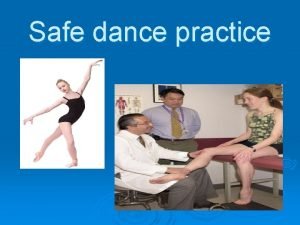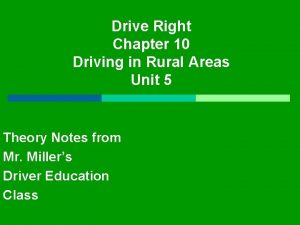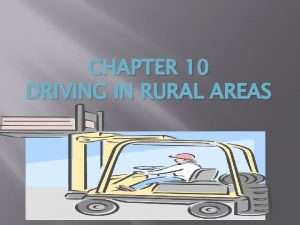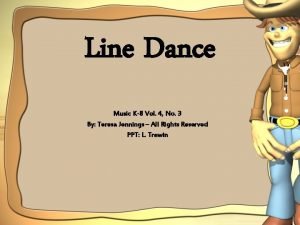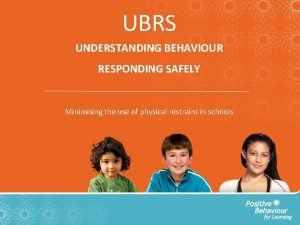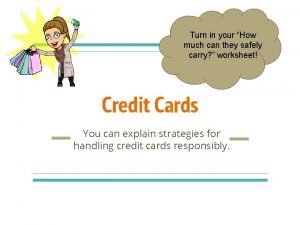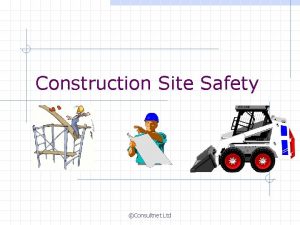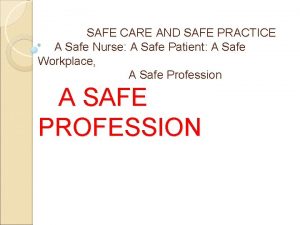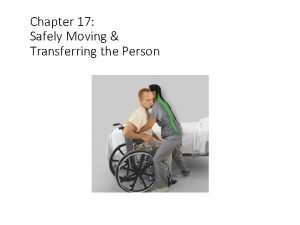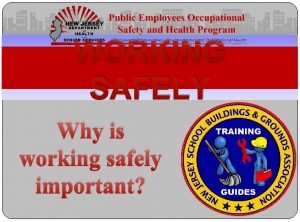Safe dance practice Rehearsing safely What should you

















- Slides: 17

Safe dance practice

Rehearsing safely What should you wear for a dance lesson?

Remember (Her Majesty Just Bought Five Cats!) ► Tie Hair back ► Wear clothes that Move with you ► Do not wear Jewellery ► Do not wear any Baggy clothes that you can get caught up in ► Ensure appropriate Footwear is worn ► Cover up

Studio Checks What checks need to be made when entering a dance studio?

Studio Checks (Lost Vest) ► Is the studio well Lit? ► Are there any Obstructions? ► Is the Space big enough? (area and height) ► Is the room Temperature appropriate? (21’C) ► Is there adequate Ventilation? ► Are there any Electrical wires trailing in the dance space ► Is the floor Surface appropriate? ► Are there any mats or other apparatus that could create a Trip hazard?

Warm Up Why do dancers need to warm up?

Why Warm up? (RIP) ► To Reduce the possibility of Injury ► To Improve Performance ► To Prepare Psychologically

What happens in a warm-up?

What happens in a warm-up? (Put Every Naughty Teenage Boy In Jail) ► Pulse is raised ► Muscles become more Elastic ► Nerve messages from the brain to the limbs speed up ► Internal body Temperature is raised ► Increase of Blood flow to the muscles ► Reduce the risk of Injury ► Joints are mobilised

Why do we Cool-down?

Why Cool-down? (Blue Peter Was Pretty Hilarious Really) ► Prevent the build up of Waste Products in the muscles (e. g. lactic acid), which helps to prevent muscle stiffness and soreness ► Prevent Blood Pooling in the muscles which can make you feel dizzy due to the reduced blood supply to the brain ► Allow the Heart Rate to gradually return to normal

Safe Practice When Performing Landing after a jump

Working with others ► Be sensitive ► Spacing ► Peripheral vision?

Supporting, Lifting & Weight Sharing What needs to be considered?

Injuries (PRICED) P-Protect R- Rest/Stop I- Ice 10 min intervals for the first 24 hours C- Compression with a moderately firm bandage E- Elevation for 24 hours for drainage of fluid D- Diagnosis or professional opinion if you concerned.

Limitations Physical/psychological limitations of the mind and body: ► Focus ► Concentration ► Commitment ► Why are they so important?

What is a balanced diet? ► Long-term health ► Preparing for exercise ► Maintaining good hydration ► Slow/fast release energy foods ► What should you eat before and after class? ► Task: 1 Week Food Diary for discussion in next week’s lesson (Mon p 3)
 Safe dance practice
Safe dance practice We're gonna dance to one song
We're gonna dance to one song Chapter 10 driving in rural areas worksheet answers
Chapter 10 driving in rural areas worksheet answers Chapter 10 driving in rural areas worksheet answers
Chapter 10 driving in rural areas worksheet answers The spot where you can no longer stop safely is
The spot where you can no longer stop safely is Safe feed safe food
Safe feed safe food Safe people safe places
Safe people safe places Ground viewing driving
Ground viewing driving Macarena line dance
Macarena line dance Everybody dance and sing line dance
Everybody dance and sing line dance Dance dance transversal
Dance dance transversal Joan needed $100 to buy a graphing calculator
Joan needed $100 to buy a graphing calculator Cm9iysdxagc -site:youtube.com
Cm9iysdxagc -site:youtube.com Understanding behaviour responding safely
Understanding behaviour responding safely How much can they safely carry
How much can they safely carry No job is so important that it cannot be performed safely
No job is so important that it cannot be performed safely Alex_eastwest13
Alex_eastwest13 No job is so important that it cannot be done safely
No job is so important that it cannot be done safely
